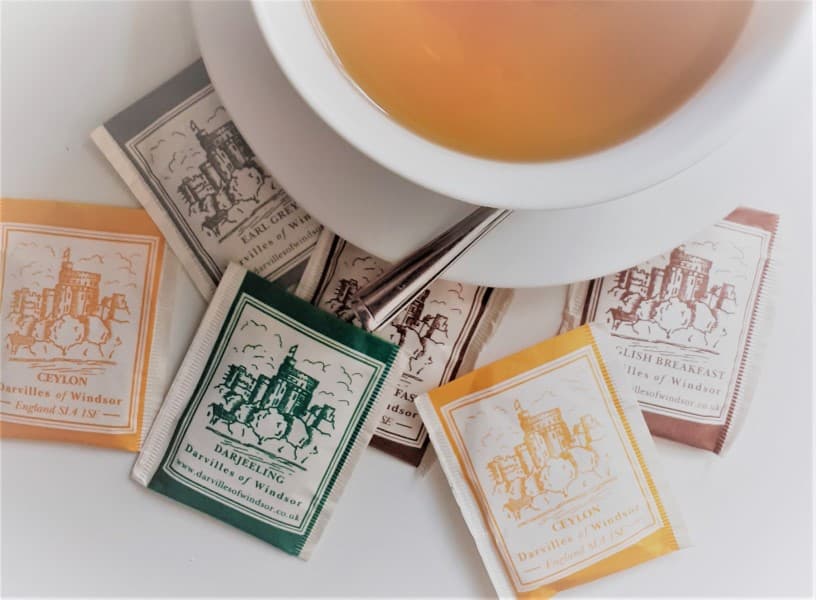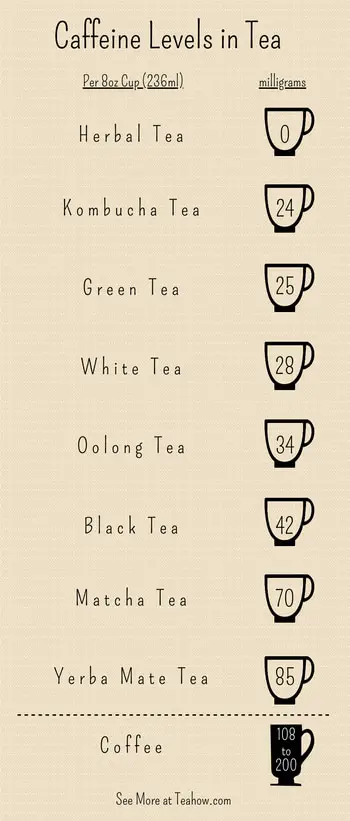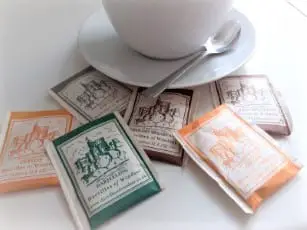One question I’m sometimes asked is does Darjeeling tea have caffeine? This is understandable, as it may sound like a tea category all of its own. The answer is simpler than you think – but there are variables. Here’s a quick answer to get you started…
Does Darjeeling tea have caffeine? Darjeeling tea contains a caffeine quantity of 40-70 milligrams. Darjeeling tea is the same as black tea, so all the properties you find in black tea are present in Darjeeling tea. They’re both made from the tea plant “Camellia Sinensis”, which is a true tea variety and contains caffeine.
Therefore, Darjeeling has the same caffeine content as black tea – right? Well, it’s not quite that simple, as there are other factors at work here. So let’s explore this further…

Does Darjeeling tea have caffeine – If so then how much?
In general, one cup of – or an 8-ounce serving of Darjeeling tea has 40 to 70 milligrams of caffeine.
This equals around one-half of the amount of caffeine in a cup of coffee.
But when comparing the caffeine levels to other true tea varieties, the caffeine content in Darjeeling tea is higher than green tea but actually lower than classic black tea.

Caffeine levels in different teas
Here’s a chart that provides some estimates on caffeine content in different types of tea, you can see where black tea (which includes Darjeeling) is in relation to other teas and beverages.
But, some also believe that Darjeeling’s caffeine content and composition are complex, and may vary further depending on the following.
1. Strength of the tea and the steeping time
The first point to make is that the stronger you make your Darjeeling tea – using more Darjeeling tea leaves/tea bags, the more the caffeine content can increase.
Some also believe that the steeping time of Darjeeling tea will decide how much caffeine you’re consuming.
Steeping for 15 minutes will release 90% of the caffeine. So if you’re concerned about the caffeine content in your Darjeeling, and want it to be lower, then steep it for 30 seconds to one minute …so it’s more akin to a decaf steeping.
But when doing this, make sure the water temperature is in the range of 185 to 206°F (85-97°C).
2. Tenderness of the tea leaves
The more tender the Darjeeling tea leaves are, then the more caffeine content it’s likely to have.
Tenderness comes from how fresh and less processed the leaves are. This also means that the older the Darjeeling leaves are, the less caffeine content it will likely have.
3. The parts of the plant from which the tea is made from
The finest and most high-quality Darjeeling or pretty much any quality tea is made from the tender moist sprigs on the tea bush. These sprigs are made from the two uppermost leaves and one bud.
So if Darjeeling tea is made using these, the quality of the tea is high and so the caffeine content will also be high.
By contrast, if the tea is made from “coarse plucking”, that is only leaves (mostly old leaves) and no buds, then your Darjeeling tea should be lower in caffeine content.
4. The flush of the tea
To add to the above reasons, the flush of the Darjeeling tea is also an element that decides how much caffeine your Darjeeling tea will have.
The tea plucking times are called flushes. For most tea varieties, the first flush has the richest flavor, properties, and aroma with equal delicacy and freshness – and so is believed to have the highest caffeine content.
As well, the first flush is also generally richer in antioxidants and nutrients.
As you’d imagine, therefore, the first flush should be more expensive. However, strangely, many believe that for Darjeeling tea, it’s the second flush that exhibits these richer flavors, and nutrients. So second flush Darjeeling tends to fetch a higher price.
It’s hard to be exact about the flush during seasons because it varies according to the location and climate of harvest among other factors like soil quality, rainfall, etc.
For Darjeeling tea that’s native to the Darjeeling region, the first flush happens anywhere between late winter to late spring (mid-march to may), whereas the second flush happens between June-mid Augusts.
Here’s a quick table to summarise it…
| First Flush Darjeeling | Second Flush Darjeeling | |
|---|---|---|
| Caffeine Content | 50-70mg | 40-60mg |
| Price | Low | High |
Does Darjeeling tea have caffeine – How to tell caffeine content
Mostly by checking and comparing. One best way you can do this is simply by checking the packaging – which should identify the caffeine content.
Often if it’s a first flush Darjeeling tea, then it’s specified as so on the packaging and then you know it should contain higher caffeine levels.
If you’re buying from a loose-leaf tea store, then there’s a good chance the tea sommelier will understand the question and may be able to answer it for you.
Another option is to compare pricing. The first flush is typically less expensive than the second flush.
So, if you’re presented with two different price brackets for your Darjeeling, then there’s a good chance the more expensive Darjeeling will contain less caffeine – all other factors being equal of course.
Does Darjeeling’s caffeine content make a difference?
No, not really. We’re talking about smaller amounts of caffeine overall, so unless you’re particularly sensitive to caffeine, or if you drink lots of Darjeeling and compound the caffeine levels, then you shouldn’t really notice too much difference.
What you’ll probably (hopefully) notice more are the rich flavor profiles that this tea has to offer. It’s not for everyone, but it needs to be experienced.
So, with that in mind, it’s time to try both first and second flush Darjeeling…
Testing Darjeeling tea
If you’re looking to try both first and second-flush Darjeeling then I’d highly recommend it, you can then see for yourself how they differ in taste – and potentially caffeine levels too.
Both First and second-flush Darjeeling teas are available from your local tea store, or online such as through Amazon.
I’ve already sourced the two products you need below, so now you can make the comparison yourself – I suspect you might be quite surprised by the price difference!
To close then
I hope this has helped to answer your question does Darjeeling tea have caffeine? All in all, both first and second flushes are both worth a try and the slight variances in caffeine levels shouldn’t really make a huge difference.
